Author: Manuel Lemos
Viewers: 2
Categories: New site features, Gamification
The idea is to give more visibility to the work of the class developers by exposing to a greater audience certain articles about their classes which may be interesting to users of the site that are not yet users of those classes.
Only certain posts will get the featured article privilege. This posts explains how it works.
Contents
Introduction
Maximizing the communication between class developers and their users
What are featured class articles?
How can a class article become featured?
Writing an article that qualifies to be featured
Enriching your articles to make them interesting
Ideas for featured class articles
Promote also your JavaScript objects with blog articles
More features to benefit class authors
Introduction
The main goal of the PHPClasses site is to maximize the exposure that the work of each contributing developer gets.
This way the developers that submit their classes can get more feedback and consequently be encouraged to keep improving their work.
In the end everybody wins. The users can get useful PHP classes that keep being improved. The class developers get more help and ideas on how to improve their code. This also benefits the projects on which they use the classes they share in the PHPClasses site.
Maximizing the communication between class developers and their users
Since its beginning in 1999, the PHPClasses site provides means for class developers to communicate with the interested users.
For instance, when a class is updated, the users that downloaded it get updated class alert messages by e-mail to let them know that a new version is available. Obviously, the users that stated they do not want to get class update alert messages will not receive them.
By the way, this feature only works if the users are logged in the site when they download it. Otherwise the site would not have a way of knowing who downloaded what, to send them e-mail notifications.
Sometimes the PHPClasses site gets criticized for imposing the login requirement. However, the login to download requirement is actually an option of the authors.
Each author may disable this requirement for each of his classes, so the users can download the class packages anonymously. But then the site is not be able to know the e-mail address of the users that should be notified when a new version of a package is released.
Therefore, despite the minor annoyance of requiring the users to be logged in, authors that keep that requirement end up benefiting of more feedback, as the site keeps their users up to date with the new package version releases.
Later in 2004 the site introduced the package forums. This allows users to ask questions, report bugs and make feature requests in individual forums dedicated to each package. This certainly improved the level of interactivity and feedback the class developers have been getting from their users.
More recently in 2009 the site introduced the package blogs. These are dedicated blogs that allows developers to write interesting articles about their classes. This way they can help their users and eventually get even more feedback from them.
The site sends an alert e-mail message to all users that have previously downloaded the package when a new post is published in the respective package blog. Then the users may come to the site, read the article and post comments about package blog article. This way developers can interact even more with their users.
What are featured class articles?
Now the PHPClasses site is introducing the featured class articles. It works like this. A developer submits an article to the blog of one of his packages. If the article covers a topic that can be considered of great interest to the site users, the article may be flagged as featured.
Featured class articles will show not only on the respective class blog but also show in the main PHPClasses blog. This provides them a much larger exposure.
So you have an idea, most classes have hundreds, thousands, or at most a few tens of thousands of users if the classes are really popular. Currently, when a post is published in the main PHPClasses site blog it is announced by e-mail to over 462,000 users. If an author posts a really interesting featured class article, now he may get a lot more feedback.
How can a class article become featured?
The most important detail to understand is that publishing a featured article is not an automatic process. Let me guide you through the necessary steps.
Assuming that you have developed a PHP class, submitted it to the PHP Classes site and it was already approved for publication, the first thing you need to do is to go on the page of your package blog. In the navigation bar of your package page, there is a link named Blog, right next to the link that says Support forum.

In the package blog page, click on a link at the end of the navigation bar that says Post article.

There you see a page with the list of articles you published in your class blog so far. Obviously the list is empty if you have not submitted any posts before. When you click on the link Submit new blog post you are lead to the blog post editor page.

There you will see a form with several fields that you will use to define your blog article content.
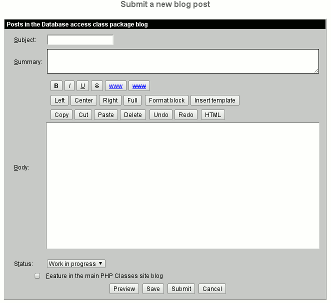
Some of the fields are pretty obvious like the one for the Subject.
The Summary field should contain just a brief description of the topics you will cover in your article. It will be displayed at the top of the article page. It ia also used as excerpt of the post in RSS feeds. Just enter two or three succinct phrases to catch the attention of your readers.
The Body field is where you will write the body of your article. It is basically an HTML editor. It has a Visual mode and and HTML mode. Usually you will use the Visual mode.
There is a toolbar with the most common formatting controls. Try to stick to formatting tags inserted by these controls. For instance use paragraph blocks for regular text, pre-formatted blocks for code, headings for titles, etc.. If you do not do this, a moderator may have to spend some time reformatting your article and it will take more time to be published.

If you need something else, you can always click on the button to go to the HTML editing mode. You can use almost all types of HTML tags but the blog system will parse the submitted HTML and automatically discard HTML tags which are considered insecure. This include any JavaScript code, inline frames, etc..
![]()
The Status field determines the state of your document. While you are editing, you should leave it in the Work in progress state. When you are done set it to Posted.

Below you have checkbox field that says Propose to be featured in the main PHP Classes site blog. As it suggests, click on that field if you would like your post to be featured in the main site blog.
![]()
If you check this option, keep in mind that when you submit the article, it will not be posted right away. A moderator will be notified to review your article to see if it qualifies to be posted as featured class article. Meanwhile, the post status will be automatically changed to Ready to publish.
Notice that if you have not yet finished your article do not set its status to Ready to publish or Posted. Once it is published, you cannot edit it again unless you ask a moderator to do it for you. Leave it in Work in progress status until you are finished. While the article is pending moderation you can still change its status to Work in progress.
Writing an article that qualifies to be featured
An article only becomes featured if the moderator agrees that it is interesting to the generality of the site users. In practice that means that you must teach something useful. Being useful is a matter of good sense.
You can write an article that teaches how to achieve a certain goal using your classes. The goal must be something useful to other users but it must not be too simple nor too confusing.
Also do not make big claims about your classes nor make comparisons to put down the work of other authors that have published similar classes. The idea is to promote your work, not put down others work.
If you submit an article that the moderator does not consider useful, or that it is too simple, you will get a message telling you why, eventually suggesting changes that you can do to make the article qualify to be approved as featured.
If you want to write a featured article and you are not sure it will be approved as featured, feel free to use the contact link at the bottom of all site pages and tell what you have in mind. Then the moderator can tell you whether it can become featured before you even start writing it.
In the worst case, your work is never wasted. If the article is not approved as featured, it will still be published in your class blog and your class users will still be notified to come and read it.
Enriching your articles to make them interesting
Whenever it makes sense you are encouraged to enrich you articles with images, videos, audio podcasts and other artifacts that can help illustrating your posts. That will certainly make them much more interesting and increases your chances of having the article be considered useful enough to be featured.
To add any of these types of artifacts, first make sure you use the Submit button in the post editor page leaving the status as Work in progress.
You will return to the blog post listing page. In the navigation bar you have links to go to the Images and files and External media pages. The Images and files page is for managing resources that need to be uploaded like images and audio. The External media page is managing resources made available in other sites like remote videos or audio.
![]()
For instance, if you want to add images for use in your class blog articles go to the Images and files page, click on the link Add a new file, choose an image file in your machine to upload, enter a Description and set the Type field to Image. You do not need to enter the file Name, unless you want it to be different from the one you have in your machine.

Likewise, if you want to add an YouTube video for use in your class blog articles go to the External media page, click on the Add new media link, enter the Media URL of the page where it is the video you want embed in your articles, enter a short Description of the video and set the Type to Video.
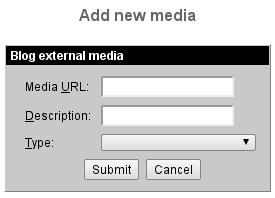
These steps do not yet add the image or video to your class blog articles. The image or video are just registered for used in any of your class blog articles.
To actually add the registered image or video to the article you were editing, click on the Posts link in the navigation bar to return to your class blog articles listing. There you may notice that the entry for your article being edited has its own links to Image and files and External media.
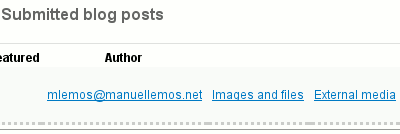
Clicking on any of these links will lead to pages on which you can manage the uploaded files or external resources associated to your blog post. Just click on the links Add a blog file to this post or Add a blog external media to this post respectively to make that association.
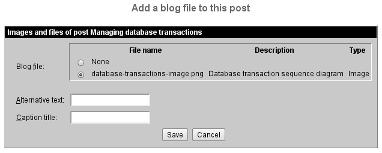

Once you do that, you are ready to use the uploaded images or embed the YouTube videos in the article. Just click on the Edit link from the blog posts listing page to return to the editor.

Now you may notice the toolbar has a button named Insert template. To insert the image or video in the post, put the editor caret in the position of the article where you want the insertion to happen, click on the Insert template button and choose the image or video to insert from a pull down menu that will appear.

The editor will insert a template mark in your article that will automatically expand to the HTML that is necessary to make your image or video appear in the article.
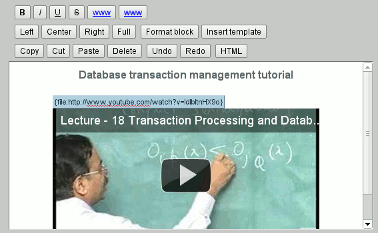
Ideas for featured class articles
If you would like to write featured articles about your classes to get them greater exposure but you are not sure what to write about, one approach is to think about frequently asked questions that you may be getting from your users. Just write tutorials on how to achieve certain purposes with your class that your users keep asking you.
If you browse the support forums of your classes and you see several people asking about the same issues, that may give you ideas about interesting featured articles.
Another suggestion is to ask your users what types of articles they would like you to write. You can use the actual class blog to post an article asking them about article ideas. Just do not propose your request articles to become featured because they do not qualify.
Anyway, since the site will notify the users that have previously downloaded your class, you will very likely get some specific feedback and ideas about interesting articles.
So go ahead, start writing interesting blog posts about your classes and publish the articles as featured so you can get plenty of feedback now.
Promote also your JavaScript objects with blog articles
If you have published a JavaScript object in the JSClasses site, or you are planning to do it later, you may also post featured articles in your JavaScript object blog and benefit from similar exposure.
More features to benefit class authors
The initiative of the class blog feature articles is just one of several ideas planned to be implemented this year to address class developers needs. Class developers are the ones that make this site useful, so it was about time to focus the site developments on features that matter to them.
Another thing that is planned to be implemented soon is a way to submit or update packages with many files with much less effort. I already mentioned this before and I will be posting about it soon.
Other than that, the site has often evolved by implementing features which were suggested by the users. If you have suggestions for other features or ideas on how to improve the current features, please post a comment to tell what you have in mind. Everybody will appreciate.
You need to be a registered user or login to post a comment
Login Immediately with your account on:
Comments:
1. Email format mobile - Jean-Christophe (2011-02-24 20:26)
I propose to format well your mobil reders email... - 4 replies
Read the whole comment and replies


